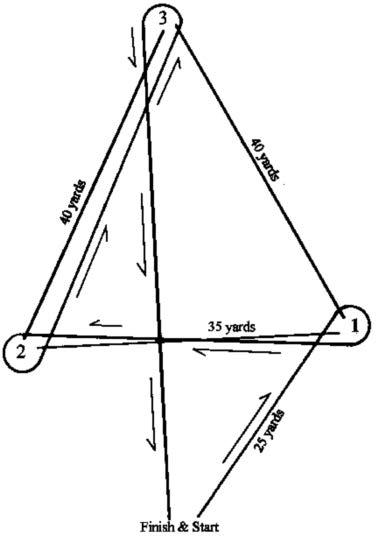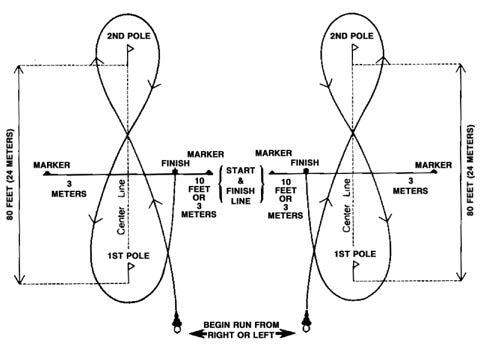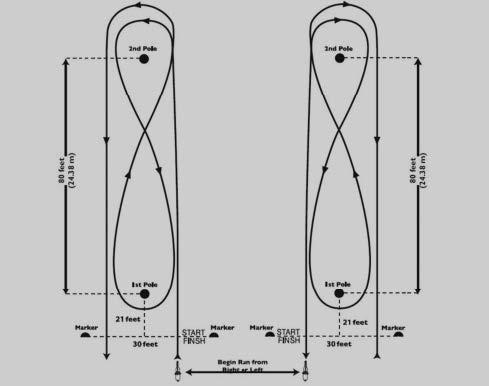
Timed event classes may also be referred to as “games,” “gymkhanas,” or “O-Mok-See.” Generally in these classes, the fastest time wins. Deviating from the described rules or pattern will result in either a time penalty or disqualification, depending on the rule infraction.
Judging
A judge’s primary responsibilities are to:
- supervise the class to make sure rules are followed.
- make sure the course is set up as prescribed by the appropriate rulebook.
- read over the rulebook prior to the event because many associations and organizations have their own rules pertaining to speed events.
- For example, in an open show, a knocked-down barrel or pole may cost the rider 5 seconds, while the same knocked-down barrel or pole may only cost the rider 2 seconds in a 4-H class.
Classes
There are a variety of timed classes, but arguably the most popular games are these:
- Barrel racing (cloverleaf)
- Pole bending
- Stake race
Barrel Racing

Barrel racing is by far the most popular timed event class. The cloverleaf pattern is designed to test the speed and maneuverability of the horse.

The rider can choose to turn the right or left barrel first; either way is acceptable.
This video from the 2009 AQHA World Show shows the rider choosing to go to the left barrel first.
- Be sure to review the rulebook the show is following before judging the barrel racing event at open shows, breed shows, rodeos, jackpots, and 4-H shows. Each show may have specific penalties and rules.
- If the course is too large for the available space, the pattern should be reduced by an increment of 5 yards until the pattern fits the arena. The distance from barrel No. 3 need not be reduced 5 yards at a time if there is sufficient room for the horse to stop. Each barrel should be set at least 15 feet from the arena wall or fence.
Pole Bending
- In this class, six poles are set 21 feet apart in the center of the arena, with the nearest pole being 21 feet from the start and finish line.
- Riders complete the course by running to the far pole, weaving down the poles and back again before running home. Similar to the barrel racing event, riders can start on either the right or left side of the poles, working the pattern from either direction.


- Again, be sure to review the show’s rulebook before judging the event as the penalties may differ.
Stake Race
The stake race is an all-out run for the money; however, it can be set up several different ways. Many open shows will set up a single pole at the far end of the arena, and riders simply run as fast as they can down the arena, turn the pole, and run back across the finish line. Yet many breed shows will use two poles and have contestants run a figure 8.

Figure 1. Stake race with start/finish line between the poles.
This video is from the 2012 AQHA World Show.

Figure 2. Stake race with start/finish line prior to first pole.
- Be sure to review the show’s rulebook before judging the event as the penalties may differ.
Resources


